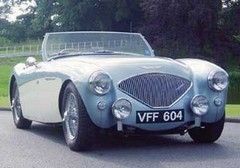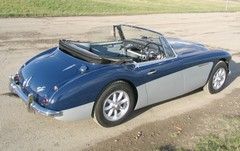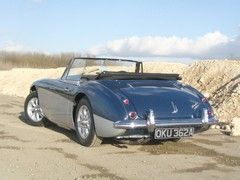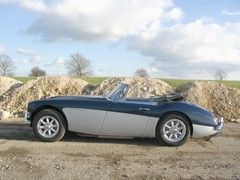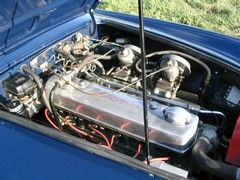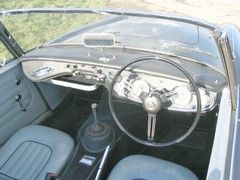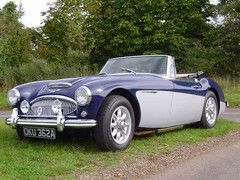The Big Healey
With two new Healeys being mooted, Graham Bell drives the original.

Austin-Healey 3000
Undoubtedly one of the most iconic sports cars, the ‘Big Healey’ was the brainchild of Cornishman Donald Healey, a man who combined technical know-how with driving ability.
Stylish and fast
Winner of the first ever RAC rally (in a Triumph) Healey subsequently joined Invicta where he both helped to develop new models and gave it several rally victories, including the 1931 Monte. From there he had a spell with Riley and became technical director at Triumph before setting up the Healey Motor Company in Warwick in 1945.
Healey’s cars were stylish and performed well, the 110mph Elliot model being the world’s fastest four-seater saloon at the time, while his Nash-engined roadster finished a creditable fourth overall at Le Mans in 1950. However, his tiny company could only make cars in small numbers and at a price that made them look expensive against the faster Jaguar XK120.
Jaguar, like MG, was enjoying huge sales success in the US at the time, and Healey knew the only way he could achieve the quantity and price needed to cash in on this lucrative market was in partnership with a big manufacturer. Consequently he approached Austin, who agreed to supply him with the running gear for a new Healey sports car.
Working in secrecy with a small team including his son Geoffrey and stylist Gerry Coker, Healey had his new car ready to debut at the 1952 Earl’s Court Motor Show.
Healey 100
Dubbed the Healey 100 after its target top speed, it was generally unremarkable mechanically, the three-speed with overdrive gearbox (later changed to four-speed with overdrive) and 2,660cc four-cylinder pushrod engine both being sourced from Austin’s A90. The chassis was a box section ladderframe with extra strength provided by integral floorpan and braced bulkhead, while suspension consisted of coils and wishbones front and leaf sprung live axle with Panhard rod at the rear, with drum brakes all round.
What really set the 100 apart was its styling, the low, sleek, modern-looking body with fold-back windsceen making the car look fast even when it was standing still, and the car’s debut caused such a sensation it was literally mobbed as people clamoured to see it.
Seeing an obvious sales winner - and no doubt with thoughts of many Dollars heading his way - Austin boss Leonard Lord struck a deal with Donald Healey that saw the car renamed (and re-badged!) the Austin Healey 100 on the very first day of the show.
The first 20 examples were built in Warwick, after which Austin was ready to start production at its Longbridge factory, and road testers of the day soon discovered that the 100 drove as well as it looked.
Roadholding and handling were regarded as far superior to most cars of the day, with mild understeer progressing to neutral drift under normal circumstances, though the 90bhp from the twin-SU Austin engine was sufficient to get the back out if provoked. It was also sufficient to propel the 940kg roadster to 60mph in just over 11 seconds and on to a top speed slightly in excess of its 100mph target - heady performance back then.
Racing
With Austin dealing with production, Healey and his team were free to concentrate on development and racing, producing special tuned versions that finished well in class at Le Mans in 1953 and gave Sterling Moss 3rd overall at the Sebring 12 hour in 1954.
As a direct result of this, two high performance versions dubbed the 100M and the 100S were produced.
The 100M was essentially a production version of the Le Mans cars offered as a higher performance option alongside the standard model, with anti-roll bars to improve handling and larger SUs and a hotter camshaft raising power to 110bhp. It was visually distinguished from the standard model by a louvred bonnet and – usually - a two-tone paint scheme.
The 100S was more specialised, with aluminium body and sub-structures, Dunlop disc brakes all round and an engine with a special aluminium ‘crossflow’ type head that gave 132bhp and 134mph. Just 55 of these cars were made in 1955, and today they’re worth a small fortune.
1956 saw Donald Healey driving versions of his car in a series of publicity generating record breaking runs, peaking with a 203mph flying mile at Bonneville in a Healey with streamlined bodywork and supercharged engine.
It subsequently transpired that these cars were in fact modified prototypes of the Austin Healey 100-6 launched later that year, which featured a new oval grille and a 2,696cc C-series straight six engine in place of the just discontinued A90 unit.
However, while Healey’s record breaking exploits hinted at great things, the actual production version of the new six-cylinder car proved to be something of a let down.
Not only was it less powerful than the 100M at 102bhp, it was also around 135kg heavier, partly due to the bigger engine and partly due to a two-inch increase in wheelbase to accommodate a couple of ‘occasional’ rear seats. Naturally this did nothing for the performance, the car still capable of topping the ton but taking around three seconds longer to reach 60mph.
In 1957 Healey production was moved from Longbridge to Abingdon and the asthmatic engine benefited from a new cylinder head and other breathing improvements that upped power to 117bhp, bringing a welcome improvement in performance. Abingdon production also saw the re-introduction of the two-seater Healey, the ‘BN6’ being produced alongside the 2+2 ‘BN4’ that sold in slightly larger quantities.
The Big Healey
Then in 1959 came a capacity hike to 2,912cc that led to the arrival of the definitive ‘Big Healey’ - the 3000.
The MkI 3000 produced 124bhp and 167lb ft, did 0-60 in 11.4 seconds and 114mph, saw the introduction of disc brakes on the front and provided the British Motor Corporation with the basis for a formidable if seemingly unlikely rally weapon.
It first grabbed the rally world’s attention in 1960 when Pat Moss (Sterling’s sister) and Anne Wisdom won the notoriously tough Liege-Rome-Liege event and it went on remain a rally frontrunner into the mid-sixties. Towards the end the works cars were producing over 200bhp, which on what were effectively normal 1960s road tyres must have made driving along snow-covered special stages in the dark a rather focusing experience!
The road cars too continued to develop, and with the MkII launched in 1961 the Healey gained the luxury of wind-up windows and a new folding hood that could be erected in seconds rather than minutes. The MkII also saw the end of the two-seater big Healey, with only 355 MkII BN7s produced.
For the final MkIII version launched in 1964 power was up to 148bhp, producing 0-60mph in 9.8 seconds and 122mph despite weight having grown to 23cwt (1,168kg). By that time, although the Austin Healey’s looks were as attractive as ever, its once outstanding chassis dynamics were looking decidedly outdated against newer sports cars like the E-Type and Elan.
The Austin Healey was killed off by British Leyland in 1968 after around 72,000 had been made (95 per cent going abroad, mostly to the USA) but the Healey legend lives on and these days it’s probably the most coveted classic British sports car after the Cobra and E-Type.
And it’s easy to see why when you drive one.
Driving the 3000
Admittedly the brakes are poor by modern standards and the cam and peg steering feels vague compared to rack and pinion, but the archaic suspension gives impressively flat cornering while the torquey long-stroke six still provides enough grunt to overtake A-road traffic and produces a wonderful roar under load.
A modern two-litre saloon might be capable of getting you from A to B just as quickly and in greater comfort, but on a sunny day in a Healey with the top down you’ll get there in more style – and with a smile on your face.
So what about a ‘new Healey’ that combines the charisma of the original with modern sports car dynamics?
Well, it’s been done once already. There was an attempt in the mid-eighties to revive the Healey Motor Company and its most famous car with the involvement of Geoffrey Healey. Unfortunately he died before things could be finalised so the new ‘Big Healey’ was made without official Healey involvement under the banner of HMC.
Dubbed the MkIV, the HMC reproduced the Healey’s classic styling in GRP, but underneath it was all new, with a TVR-style tubular backbone chassis, all-round independent suspension with disc brakes and a fuel injected Rover V8. As with the Austin Healey, most went abroad (it was sold exclusively in Germany until 1995) with production only ending quite recently when HMC went out of business.
So how will the two cars currently being touted fare? Obviously only time will tell, but the prospect of a ‘new Healey’ is something to be welcomed by any sports car enthusiast.
Thanks to The Open Road classic car hire for the use of its Austin Healey 3000 MkIIA.
Links
Related stories:
© Copyright Graham Bell 2006
 TR6 / TR250?
TR6 / TR250? Cobra and E are in a different price-bracket . . . although a well-sorted H does pretty well these days.
Gassing Station | General Gassing | Top of Page | What's New | My Stuff

